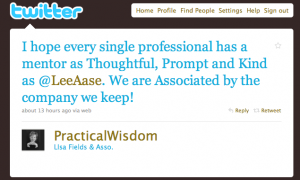I enjoy giving webinar presentations like this one, but I often think of slides I wish I would have added, and examples I would like to share, after I’ve submitted the presentation file to the organizers. And sometimes I forget to mention some points that I had intended.
One of the beauties of blogging is that I can share some additional notes and highlights so that people who participated in the webinar can explore on their own. It lets me make sure I covered the key points before the presentation even starts. Some of this may be review for long-time SMUGgles, but you may find portions helpful as well.
The main point about doing this before 5 p.m. is to not procrastinate. Those in the EST time zone will have a couple of hours after the webinar, while the PST gang has the whole afternoon. But since you’re reading this now, why not get started right away?
- Observe some examples. Check out our Mayo Clinic Podcast Blog (and particularly this post on Niemann-Pick Disease Type C), our Mayo Clinic YouTube Channel, our Facebook page and our News Blog. See this story from yesterday’s Wall Street Journal that includes a link to a Mayo Clinic Medical Edge video story, and this post from the WSJ’s Health Blog, which included one of our Flip videos from our YouTube channel. Besides providing information directly to consumers and potential patients, “new media” tools like web video and audio can help generate or enhance your traditional news coverage.
- Complete Podcasting 101, which is the first course in the Podcasting curriculum at SMUG. In the coming days, as you work through the 100-level courses, you will be able to create your own podcast and have it listed in iTunes for exactly $0.00. It’s all free. Like my podcast, Chancellor Conversations, this won’t have the production quality you would want for your official organization podcasts, but by working through the process step-by-step you will strip away the mystery, and no one will be able to tell you “it’s too complicated.” Then you can spend a few hundred dollars for some better recording equipment, and develop a really solid, low-cost, high-quality communication vehicle.
- Enroll in SMUG. The tuition is $37,700 less than Johns Hopkins. If you or your organization spend at least a few hundred dollars on a webinar, or thousands to attend a conference, to learn about social media, wouldn’t it be silly to not take the next step and get some hands-on experience, particularly when it’s free? Besides joining the SMUG Facebook group, you can friend me (be sure to mention the webinar), or follow me on Twitter. SMUG’s mission is reflected in our motto, and our goal is to help you discover what you can do at a ridiculously low cost (or perhaps even for free) and without any support from your IT department. In economic times like this, as Jacopo asked Edmond Dantes in The Count of Monte Christo, “How is that a bad plan?”
- Check out Slideshare.net. I thought Elizabeth Tracey’s point about connecting audio files with Powerpoint presentations was good, and Slideshare is a way you can do it today, for free. Here’s a link to one of my slidecasts from the Podcasting curriculum to demonstrate. Slideshare is like YouTube for PowerPoints; you can embed it in your own blog or site, and also can make it available in the “marketplace” for others to find and embed, increasing your reach.
- Complete Social Media 101, which is part of the Core Courses curriculum at SMUG and originally was my “12-Step Social Media Program for PR Professionals.” As in all similar programs, the first step is to admit that you have a problem. Social Media 101 will give you an introduction to the broad scope of social media tools that may have application in your work.
In addition to the five free things before 5 p.m., here’s a bonus you should do after 6 tonight. It’s not free, but you’ll be glad you did it:
Get a Flip video camera.
You can find them for $150 or so at Wal-Mart or Best Buy. If you’re into the delayed gratification thing and want to work through more of the SMUG curriculum, I hear you can get them even cheaper at Amazon.com. Consider it a Christmas gift to yourself. Spend another $15 or so for a tripod. You’ll want to have this for personal use; it’s the video camera you can always have with you, so you never miss those magic moments because you forgot to bring the camera bag. But then take the Flip to work and see how you can use it for business purposes.
I hope you found the presentation (and this post) helpful, and would appreciate any feedback in the comments below.
